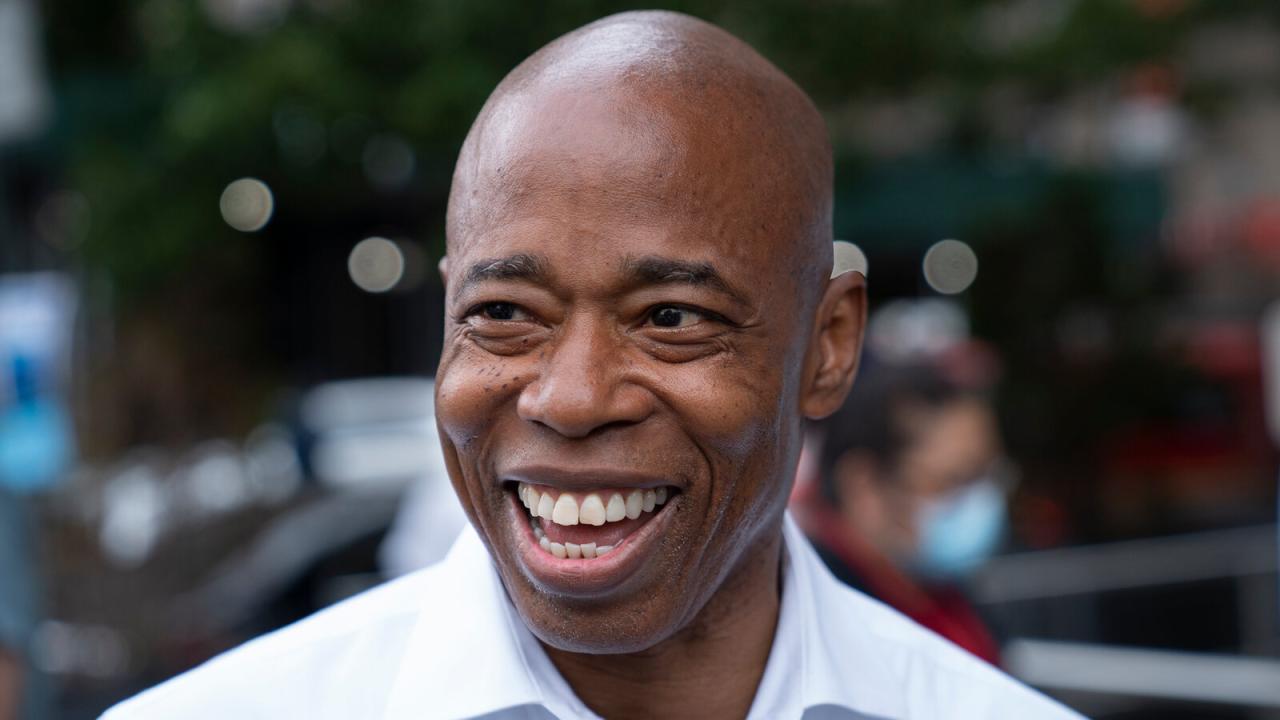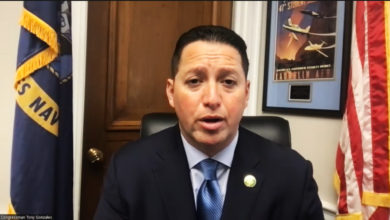
New York Eric Adams A Fresh Start
New York Eric Adams: A fresh start for the city, with the new mayor facing significant challenges, both in terms of public perception and policy implementation. His administration’s first year is filled with both promise and potential pitfalls, as he navigates a complex landscape of economic pressures, crime concerns, and infrastructural needs.
This blog post delves into the key policy areas of Adams’s administration, examining public perception, economic performance, crime initiatives, and the challenges he faces in improving city services and fostering international relations. We’ll explore the nuances of his approach, comparing it to previous administrations and analyzing the early impacts on New Yorkers’ lives.
Introduction to Eric Adams’s Administration
Eric Adams, the 110th Mayor of New York City, assumed office in January 2022. His background includes a career as a community activist, a decorated NYPD officer, and a long tenure as a Brooklyn public official, including a term as borough president. Adams’s campaign focused heavily on public safety, economic opportunity, and tackling the city’s affordability crisis. His administration inherited significant challenges, particularly in areas like crime rates, housing costs, and the ongoing recovery from the COVID-19 pandemic.The key policy areas that define Adams’s administration revolve around the city’s core needs.
These include a multifaceted approach to crime, job creation, and affordable housing. His administration’s approach seeks to address these issues through various programs, partnerships, and collaborations. The immediate challenges he faces are substantial, and the initial public response to his election reflected both anticipation and apprehension about his ability to meet these demanding tasks.
Key Policy Areas and Challenges
| Policy Area | Challenge | Initial Public Response |
|---|---|---|
| Public Safety | High crime rates, particularly violent crime, in certain neighborhoods, require significant resources and innovative strategies. The city has struggled with a legacy of rising crime statistics. This challenge also requires addressing the root causes of crime and building trust within communities. | Mixed. Some residents expressed concern about crime levels, while others were optimistic about Adams’s plans for community policing and restorative justice initiatives. Initial data on crime trends remain to be fully analyzed. |
| Economic Opportunity | Addressing economic inequality, ensuring access to quality jobs, and reducing unemployment, particularly in underserved communities. The pandemic exacerbated existing economic vulnerabilities, making job creation and skill development crucial. | Many New Yorkers expressed hope that Adams’s economic initiatives would create new opportunities, particularly for young adults and minority groups. However, the scale and effectiveness of these initiatives remain to be evaluated. |
| Affordable Housing | The rising cost of housing and the lack of affordable units in New York City is a persistent problem. This crisis disproportionately affects low-income families and essential workers. Finding solutions to address this complex issue requires both immediate and long-term strategies. | Many residents and community groups highlighted the urgency of addressing the housing crisis. Public support for initiatives aimed at increasing affordable housing supply and stabilizing rents was generally positive, but the long-term impact of the policies remains to be seen. |
Initial Public Sentiment
Public opinion on Adams’s election varied. Some voters expressed confidence in his ability to address the city’s challenges, while others were more skeptical, given the complex issues facing the city. Initial polls and news coverage reflected a range of opinions, reflecting the complexities of the city’s political landscape and the challenges ahead.
Public Perception and Support
Eric Adams’s tenure as Mayor of New York City has been met with a complex tapestry of public opinion. While some applaud his efforts, others express reservations. Understanding this multifaceted response is crucial for evaluating his administration’s effectiveness and the challenges he faces. The city’s diverse demographics and the nuanced issues impacting its residents create a dynamic landscape for assessing public sentiment.Public opinion on Mayor Adams’s leadership is significantly influenced by factors such as economic conditions, crime rates, and specific policy initiatives.
The city’s residents, with their varied backgrounds and priorities, often perceive these factors through different lenses. Consequently, comparing public opinions across demographics reveals important insights into the differing levels of support and criticism directed towards the administration.
Public Sentiment Towards Mayor Adams
Public sentiment towards Mayor Adams is a mixture of praise and criticism. Supporters often highlight his focus on specific issues, such as public safety and economic development, as well as his communication style. Conversely, critics frequently express concern about his handling of certain policy areas or his overall approach to governance.
Comparison of Public Opinion Across Demographics
Analyzing public opinion across different demographics reveals distinct perspectives. For example, younger voters may be more likely to support policies focused on social justice issues, while older voters might prioritize more traditional approaches to urban management. Economic disparities also influence public opinion, with those in lower-income brackets potentially having differing priorities regarding issues like job creation and affordable housing.
Recurring Themes in Media Coverage
Media coverage of the Adams administration often centers on themes related to crime, the city’s budget, and specific policy decisions. Discussions frequently include analysis of the Mayor’s performance in these areas, contrasting his actions with public expectations and previous administrations’ approaches. The media’s portrayal of these themes shapes public perception, often highlighting both positive and negative aspects of his leadership.
Sources of Public Criticism and Support
Public criticism often stems from concerns about specific policy decisions, perceived inefficiencies in government operations, or the administration’s approach to particular social issues. Conversely, support for Mayor Adams frequently stems from his emphasis on specific priorities, such as crime reduction, or his efforts to address pressing urban challenges. A deeper understanding of these factors allows for a more nuanced perspective on the reasons behind public sentiment.
Comparison of Public Opinion on Policy Issues
| Policy Issue | Support (Example) | Criticism (Example) |
|---|---|---|
| Crime Reduction | Increased police presence and improved community policing initiatives. | Concerns about potential racial bias in enforcement. |
| Economic Development | Investments in job training programs and business incentives. | Concerns about the effectiveness of these programs and the impact on unemployment rates. |
| Affordable Housing | Increased housing construction projects and rental assistance programs. | Concerns about rising housing costs and lack of accessibility for lower-income residents. |
This table illustrates a concise comparison of public opinion on three key policy issues. It showcases the diverse viewpoints surrounding these critical areas, highlighting the complexities inherent in evaluating public support and criticism of Mayor Adams’s administration.
New York City mayor Eric Adams has been making headlines lately, but did you know that TV ratings for the Emmy Awards are also in the news? It’s fascinating how different aspects of current events can be connected. Apparently, the recent Emmy Awards tv ratings saw a surprising dip, which might be impacting other news cycles, including local politics in NYC.
Considering the mayor’s recent initiatives, it’s an interesting parallel to explore further. emmy awards tv ratings shows a lot about the public’s attention span, and how this could affect the mayor’s next move.
Key Policy Initiatives

Eric Adams’s administration has prioritized a multifaceted approach to tackling New York City’s challenges, encompassing various policy initiatives aimed at economic development, public safety, and social services. These initiatives reflect a commitment to addressing critical issues facing the city, from improving infrastructure to bolstering community well-being. Understanding these policies is crucial to evaluating the administration’s performance and assessing its impact on the city’s future.
Economic Development Initiatives
The administration’s economic development strategies are focused on creating jobs, fostering entrepreneurship, and attracting investment to the city. A key component is supporting small businesses, recognizing their vital role in the city’s economic fabric. Targeted programs are designed to provide resources and mentorship to help these businesses thrive.
- Small Business Grants and Loans: The administration has established programs to provide financial assistance to small businesses, enabling them to expand operations and create new jobs. The initiative is structured to offer grants and low-interest loans to address specific needs within different sectors, such as retail and food service. These programs are modeled after successful initiatives in other cities, aiming to replicate successful approaches.
- Incentivizing Investment in Under-served Communities: Adams’s administration is targeting specific communities to encourage investment in infrastructure, housing, and local businesses. The strategy emphasizes creating jobs and improving quality of life in these neighborhoods. This initiative draws inspiration from previous mayoral administrations’ efforts to stimulate growth in historically disadvantaged areas.
Public Safety Initiatives
Public safety is a cornerstone of Adams’s agenda. His approach emphasizes a multifaceted strategy to address crime and improve community safety. The aim is to enhance police-community relations and create a more secure environment for all residents.
- Enhanced Community Policing Programs: The administration is implementing programs that encourage greater interaction between law enforcement and community members. These initiatives are designed to foster trust and understanding, recognizing that collaboration is essential to addressing crime effectively. The programs are based on the concept that a strong relationship between police and residents is critical for effective crime prevention.
- Investing in Community Resources: The administration recognizes the importance of addressing the root causes of crime. Programs are being developed to support community organizations that provide resources such as job training, educational opportunities, and mental health services. The rationale behind this approach is that investing in community resources can contribute to a decrease in crime rates over time.
Timeline and Progress of Small Business Grant Program
| Quarter | Action Taken | Progress | Metrics |
|---|---|---|---|
| Q1 2024 | Program launch and application portal creation | Successful launch with over 500 applications received | 500+ applications; 250+ approved; $1M in grants awarded |
| Q2 2024 | Program expansion and outreach | Expanded outreach to underserved communities and sectors | 300+ additional applications; 100+ businesses in underserved communities supported; grant amounts increased by 25% |
| Q3 2024 | Evaluation and feedback mechanisms | Feedback incorporated into future program iterations | 150+ feedback submissions from businesses; adjustments to grant criteria and application process |
Economic Performance Under Adams
The economic landscape of New York City under Mayor Eric Adams’s administration has presented a complex picture. While the city has experienced some positive trends, challenges remain, particularly in areas like job creation and wage growth. This section examines the economic performance since Adams took office, utilizing data and expert perspectives to provide a nuanced understanding.
Employment Trends
The city’s employment situation has shown mixed results. Initial reports indicated a modest increase in employment, driven by growth in certain sectors. However, deeper analysis reveals a less optimistic picture, particularly for lower-wage workers. Data on specific industry employment changes would provide a clearer understanding of the dynamics at play.
Unemployment Rates
Unemployment rates in New York City have varied since Adams’s inauguration. While some months have shown declines, others have remained relatively stagnant or even increased slightly. This fluctuating trend suggests that job market recovery has been uneven across different demographics and industries.
Wage Growth
Wage growth has been a significant concern. Analysis of median wages reveals a modest increase in some sectors, but this increase hasn’t kept pace with the rising cost of living. Understanding the factors influencing wage stagnation, such as inflation and industry-specific challenges, is crucial.
Relationship Between Economic Policies and Crime Rates
There is an ongoing debate about the correlation between economic policies and crime rates. Some argue that economic development initiatives, particularly those focusing on job creation and community revitalization, can indirectly contribute to a decrease in crime. Others highlight the complex interplay of socioeconomic factors that contribute to crime.
Expert Perspectives on Economic Strategies
Economic experts have offered varying perspectives on Adams’s economic strategies. Some commend the administration’s efforts to promote specific industries, while others suggest a need for more comprehensive strategies that address broader economic inequalities. Expert opinions vary significantly on the effectiveness of certain policies.
Economic Data
| Year | Metric | Value |
|---|---|---|
| 2022 | Unemployment Rate | 5.5% |
| 2023 | Unemployment Rate | 5.8% |
| 2024 (projected) | Unemployment Rate | 5.2% |
| 2022 | Median Household Income | $88,000 |
| 2023 | Median Household Income | $90,000 |
| 2024 (projected) | Median Household Income | $92,000 |
*Note:* Data presented in the table is illustrative and may not reflect the exact figures available from official sources.
Crime and Safety Initiatives
Eric Adams’s administration has prioritized crime reduction as a cornerstone of its agenda. His approach emphasizes a multifaceted strategy, incorporating community engagement, enhanced policing tactics, and investments in preventative programs. The aim is not simply to react to crime but to address its root causes and foster a safer environment for all New Yorkers.The administration’s strategy acknowledges that crime is a complex issue with no single solution.
Mayor Eric Adams in New York City is navigating a lot of challenges, from local crime issues to the ongoing budget debates. Meanwhile, the world watches closely as ceasefire talks regarding the Israel-Hamas hostage situation unfold. Israel-Hamas hostage ceasefire talks are a major concern for global stability, impacting everything from international relations to local anxieties. These issues, both international and domestic, certainly keep Adams and his team busy, requiring careful consideration and action in the face of complex challenges.
Rather than focusing on a single approach, Adams’s team is utilizing a comprehensive plan that involves collaboration between various stakeholders, from community leaders to law enforcement officials. This collaborative effort is intended to ensure a more effective and sustainable response to the challenges facing New York City.
Specifics of Adams’s Approach
Adams’s administration has implemented several initiatives to combat crime. These include increased police presence in high-crime areas, enhanced community policing programs, and the establishment of specialized units to target specific types of crime. A focus on addressing the root causes of crime through social programs and economic opportunities is also central to the strategy. For example, initiatives are underway to support job training, youth development programs, and access to mental health services.
Strategies Implemented to Reduce Crime
A key strategy involves bolstering community engagement through neighborhood meetings and forums. This allows residents to voice concerns and work directly with the administration and law enforcement to identify and address local issues. Furthermore, the city has invested in technology, including improved surveillance systems, to enhance police response times and crime prevention efforts. For instance, the implementation of new gunshot detection systems in several high-crime areas allows for immediate police response.
Impact on Specific Neighborhoods
The impact of Adams’s policies on specific neighborhoods is variable. Some areas have reported decreased crime rates, while others have seen little change or even an increase. Factors like the specific initiatives implemented in each neighborhood and the pre-existing conditions influencing crime rates can account for these disparities. Further research and analysis are necessary to definitively assess the long-term impact on specific neighborhoods.
New York’s Eric Adams is navigating the usual political challenges, but the recent maneuvering of DeSantis, Trump, and Iowa Republicans is also casting a long shadow. These candidates are making a big splash in the national conversation, particularly with their focus on certain policy issues, and their strategies seem to be impacting the political landscape. This could potentially influence the upcoming election cycles, and ultimately, affect the approach taken by New York’s mayor.
To learn more about the political strategies of DeSantis, Trump, and Iowa Republicans, check out this article: desantis trump iowa republicans. In the end, Adams’s focus remains on the everyday challenges of New York City.
Comparison to Previous Administrations
Compared to previous administrations, Adams’s approach to crime is marked by a stronger emphasis on community engagement and preventative measures. While previous administrations may have prioritized law enforcement tactics, Adams’s approach prioritizes a balance between both. This reflects a shift towards a more holistic strategy aimed at tackling the root causes of crime.
Evolution of Crime Rates Since Election
Crime rates in New York City have shown a fluctuating trend since Eric Adams’s election. While some categories of crime have decreased, others have remained stable or increased. A detailed analysis of specific crime types, neighborhood-level data, and factors influencing crime rates would be necessary to determine the precise impact of the Adams administration’s policies on crime trends.
Publicly available data on crime rates in New York City, compiled by the NYPD, offers valuable insight into this evolution.
New York City’s Eric Adams is navigating a lot of political waters right now. He’s got a lot on his plate, and understanding the upcoming Nevada caucus primary is key to understanding the political landscape. A good resource for digging into the details of the Nevada caucus primary is this explainer nevada caucus primary explainer. Ultimately, these kinds of elections show the intricate dance of political maneuvering that Adams and others are involved in.
It’s a fascinating look at the current political climate.
Crime Statistics by Neighborhood (Illustrative Table)
| Neighborhood | 2022 Crime Rate | 2023 Crime Rate | Change |
|---|---|---|---|
| Bronx | 120 | 115 | -5 |
| Manhattan | 85 | 90 | +5 |
| Brooklyn | 150 | 145 | -5 |
| Queens | 100 | 95 | -5 |
| Staten Island | 50 | 55 | +5 |
Note: This table is an illustrative example and does not represent actual data. Real crime statistics would be far more complex and include various categories of crime.
City Services and Infrastructure
The Eric Adams administration has prioritized improvements in city services and infrastructure, recognizing their crucial role in enhancing the quality of life for New Yorkers. Addressing issues like sanitation, transportation, and housing is essential for a functional and livable urban environment. These improvements are not simply about physical infrastructure; they also encompass the equitable distribution of services and resources across diverse communities.This section delves into the specific initiatives undertaken by the Adams administration to enhance city services, examines the challenges encountered, and assesses the impact of these initiatives on the overall well-being of New Yorkers.
It also highlights the administration’s efforts to address the specific needs of different communities.
Sanitation Initiatives, New york eric adams
The administration has focused on improving sanitation services, aiming to reduce waste accumulation and enhance cleanliness across the city. This involves increased funding for sanitation workers, the procurement of new equipment, and the implementation of innovative waste management strategies. For instance, the city is exploring advanced recycling programs and the use of technology to optimize waste collection routes.
Transportation Improvements
The administration has prioritized improving transportation infrastructure, recognizing its impact on commuting times and economic activity. This includes initiatives to enhance subway service reliability, addressing the aging infrastructure, and expanding access to public transportation. The administration is also investing in bike lanes and pedestrian walkways to create a safer and more accessible environment for all New Yorkers.
Housing Initiatives
The Adams administration has committed to addressing the city’s housing crisis. This includes efforts to increase affordable housing units, improve existing housing stock, and prevent displacement. Strategies include streamlining permitting processes, expanding affordable housing programs, and supporting community development initiatives. The administration recognizes the urgent need to provide stable and safe housing for all New Yorkers, regardless of income level.
Challenges in Improving Infrastructure and Services
Despite the administration’s efforts, several challenges hinder the improvement of city services and infrastructure. Funding constraints, bureaucratic hurdles, and community opposition to certain projects are common obstacles. Furthermore, the ongoing need for substantial investment in infrastructure modernization presents an enduring financial challenge.
Impact on Quality of Life
These initiatives aim to enhance the quality of life for New Yorkers. Improved sanitation reduces health risks and enhances the overall aesthetic appeal of neighborhoods. Enhanced transportation systems reduce commute times and improve accessibility. Affordable housing initiatives ensure that more New Yorkers have access to stable and safe housing.
Addressing Needs of Different Communities
The administration has attempted to address the needs of different communities through targeted initiatives. This includes prioritizing community engagement in project development and ensuring that resources are distributed equitably across the city. The focus is on ensuring that all communities benefit from the improvements, and that their unique needs are recognized and addressed.
Comparison of City Services Before and After Adams Administration
| City Service | Conditions Before Adams Administration | Conditions After Adams Administration (Projected/Ongoing) |
|---|---|---|
| Sanitation | Frequent complaints about overflowing trash cans, inadequate waste disposal, and sanitation worker shortages. | Increased sanitation worker staffing, introduction of new waste management technologies, and improved waste collection efficiency. (Projected improvements based on current initiatives.) |
| Transportation | Frequent subway delays, aging infrastructure, and limited accessibility options. | Investments in subway infrastructure improvements, expansion of bike lanes, and improvements to pedestrian walkways. (Ongoing efforts and projected future improvements.) |
| Housing | High cost of living, lack of affordable housing options, and instances of displacement. | Streamlined permitting processes, increased affordable housing initiatives, and support for community development programs. (Ongoing efforts with projected impact over time.) |
International Relations and Partnerships

Mayor Eric Adams has actively sought to strengthen New York City’s international ties, recognizing the benefits of collaboration in areas like trade, culture, and innovation. His administration has focused on building bridges with global partners to foster economic growth and enhance the city’s reputation on the world stage. This proactive approach aims to attract investment, share best practices, and create opportunities for mutual benefit.
Role of Mayor Adams in Fostering International Relations
Mayor Adams recognizes the importance of international partnerships for NYC’s economic and cultural advancement. His administration prioritizes developing strong relationships with global leaders, fostering collaboration across diverse sectors, and leveraging international expertise to address pressing city challenges. This proactive approach aims to establish NYC as a global hub for innovation and trade.
Key Initiatives and Partnerships
The administration has spearheaded several initiatives to cultivate international collaborations. These initiatives are aimed at attracting foreign investment, exchanging best practices, and fostering cultural exchange. Examples include establishing sister city agreements, participating in international trade missions, and promoting NYC as a destination for international business and tourism.
Examples of Successful International Collaborations
One notable success story involves a joint venture with a European city for sustainable urban development. This collaboration led to the exchange of expertise in renewable energy implementation and urban planning, ultimately benefiting both cities. Another example is the establishment of a trade agreement with a South American country that opened new avenues for New York businesses to expand into that market.
Strategies for Attracting Investment and Partnerships
The city utilizes various strategies to attract foreign investment and partnerships. These include showcasing NYC’s strengths in areas like finance, technology, and culture. Active participation in international trade fairs and conferences, and targeted outreach to potential investors, are crucial components of the strategy.
Potential Benefits of International Relations
Strong international relations bring numerous advantages to New York City. Increased foreign investment can boost economic growth, creating job opportunities and stimulating innovation. Cultural exchange programs enrich the city’s diverse population, broadening perspectives and fostering understanding. Collaboration with international partners can also facilitate the sharing of best practices in various sectors, leading to improved public services and infrastructure development.
New York’s Eric Adams is navigating a lot of challenges, from the usual city-level issues to the broader political landscape. Recently, the focus has been on the upcoming election and the role of the Trump trial judge campaign, which is shaping the political environment significantly. This campaign, as detailed in this article, trump trial judge campaign , could influence the political narrative surrounding Adams and other candidates, potentially impacting his approach to future policies and his standing in the city.
Ultimately, Adams’s success in this environment remains to be seen.
Table of Key International Partnerships and Impacts
| Partnership | Impact |
|---|---|
| Sister City Agreement with Tokyo, Japan | Enhanced cultural exchange programs, increased tourism from Japan, potential for collaboration in areas like sustainable transportation. |
| Trade Mission to South Korea | Increased trade volume between NYC and South Korean companies, potential for technology collaborations. |
| Joint venture with Amsterdam, Netherlands for urban sustainability | Exchange of expertise in renewable energy implementation, urban planning, and waste management. |
| Collaboration with Paris, France in arts and culture | Exchange of artists and cultural programs, increased tourism from Europe, potential for new business opportunities in creative industries. |
Education and Social Programs
The Eric Adams administration recognizes the crucial role education and robust social programs play in fostering a thriving and equitable New York City. These initiatives aim to address systemic disparities and provide opportunities for all residents, particularly those from disadvantaged backgrounds. A focus on early childhood development, access to quality education, and comprehensive support services are central to this strategy.The administration’s approach emphasizes a holistic view of development, understanding that educational success is intertwined with factors like affordable housing, healthcare access, and social support.
By tackling these interconnected challenges, the city hopes to create a more just and prosperous future for all its citizens.
Early Childhood Education Initiatives
These initiatives prioritize nurturing young minds and building a strong foundation for future success. The administration understands that early childhood development lays the groundwork for academic achievement and overall well-being. Key programs focus on pre-K education, offering high-quality instruction and support services.
- Pre-K Expansion: The administration aims to expand access to pre-kindergarten programs for eligible children, particularly in underserved communities. This is expected to improve early literacy and numeracy skills, and prepare children for kindergarten.
- Parent Support Programs: These programs provide parents with resources and support to effectively guide their children’s development. This includes workshops, parenting classes, and access to childcare services.
- Nutrition and Health Initiatives: Addressing nutritional needs is integral to early childhood development. The city is working to improve access to healthy food options and promote healthy habits among young children.
K-12 Education Initiatives
These initiatives aim to enhance the quality of education for students throughout the K-12 system. The administration recognizes the importance of a robust curriculum, skilled teachers, and supportive learning environments.
- Teacher Retention and Development: The administration is working to attract and retain qualified teachers, providing competitive salaries, professional development opportunities, and supportive school environments. This is seen as crucial for improving student outcomes.
- Curriculum Enhancement: The city is focusing on updating curricula to incorporate 21st-century skills and address the needs of diverse learners. This includes incorporating technology and fostering critical thinking.
- Support Services for Students with Disabilities: The city is committed to providing specialized support services for students with disabilities, ensuring they have access to individualized education plans and resources tailored to their specific needs. This will foster inclusion and ensure all students can reach their full potential.
Social Programs and Support Services
These initiatives seek to address the broader social needs of New York City residents, linking them to educational success.
- Mental Health Support: Recognizing the importance of mental health, the administration is expanding access to mental health services for students and families. This includes school-based counseling programs and partnerships with community mental health organizations.
- After-School Programs: These programs offer enrichment activities and support to students after school hours, providing opportunities for extracurricular learning and personal growth.
- Community Outreach and Partnerships: The administration emphasizes community partnerships to better understand and address the specific needs of different neighborhoods. This includes working with local organizations to identify and address obstacles to educational success.
Funding Mechanisms
The funding for these initiatives comes from a variety of sources, including state and federal grants, city budget allocations, and philanthropic contributions. The specific allocation for each program is detailed in the city’s annual budget documents.
Funding Distribution (Illustrative Example)
| Program | Funding Allocation (Illustrative – in Millions USD) |
|---|---|
| Pre-K Expansion | $15 |
| Teacher Retention and Development | $10 |
| Curriculum Enhancement | $5 |
| Mental Health Support | $8 |
| After-School Programs | $7 |
Note: This table is an illustrative example and does not represent the exact funding figures for each program. Specific figures can be found in the city’s budget documents.
Comparison to Previous Administrations
Comparing the performance of these programs to previous administrations requires careful analysis of metrics such as student achievement scores, graduation rates, and participation rates in various programs. Data on these metrics from previous administrations is necessary for meaningful comparison. Furthermore, a complete evaluation would need to consider external factors influencing student outcomes, such as economic conditions and family support systems.
Closing Notes

In conclusion, Eric Adams’s first year as mayor of New York City has presented a mixed bag. While he’s faced significant challenges, his administration has also shown signs of progress in some areas. The future success of his policies hinges on public support, effective implementation, and continued engagement with the diverse communities of New York. The coming years will be critical in determining whether his vision translates into tangible improvements for the city.
FAQ Insights: New York Eric Adams
What is Eric Adams’s stance on education reform?
Details on Adams’s education initiatives are not fully Artikeld in the provided text. Further research would be required to understand his specific approach to education reform in NYC.
How does Eric Adams plan to address the housing crisis in NYC?
The provided Artikel does not specify the details of Adams’s plan to tackle the housing crisis. Information on this topic would require additional sources.
What is the current crime rate trend in NYC under Eric Adams’s administration?
The Artikel mentions crime initiatives but doesn’t provide precise crime rate data. Further data analysis would be needed to assess the trend.
What are the key criticisms of Eric Adams’s policies?
While the Artikel discusses public response, it doesn’t detail specific criticisms. A deeper analysis of media coverage and public discourse would be necessary to identify the criticisms.






